Artifacts
By Betsy HolmquistFootball
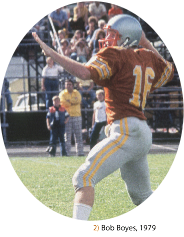
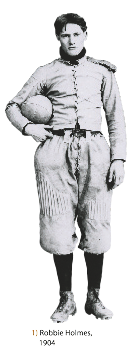 The History of Grizzly Sports Uniforms
The History of Grizzly Sports UniformsFabrics, fashion, technology, and budget tell much of the story of Grizzly sports uniforms. Early UM football players cobbled together their uniforms—stitching on leather and sheepskin—to fit their needs. There were no pockets in their canvas pants to insert the molded pads like today’s players use. No gloves. No cleats. No chest protectors, only a sweater under—or over—a laced vest that might include shoulder pads. (1) There was no moisture-wicking under jerseys or custom-designed helmets with face protectors that current Grizzlies enjoy—only a padded, ear-flapped cap, if any. Most early players wore no headgear at all until leather helmets, called “dog ears,” and resembling early aviator headgear, appeared in the 1920s. Plastic helmets debuted following World War II and have been refined and redesigned every year since, as have the shoes. (2)
Today’s Grizzlies may have up to five pairs of shoes depending on field and weather conditions. They now also have practice uniforms, workout gear, cold-weather gear, custom-fitted helmets that are adjusted before and during every game, and several Nike game-day uniforms. The era of cotton, canvas, and wool uniforms and leather hand-sewn pads has long passed. Synthetic fibers and materials will continue to dictate the design, comfort, and style of future sports uniforms. And the budget? Outfitting one Grizzly football player today costs $1,500.

Men’s & Women’s Basketball
Bows, blouses, and bloomers best describe the first women's basketball uniforms. (3) Sailor, or middy tops, were another uniform choice for women athletes—usually physical education majors—who earned points toward their letters for classroom and intramural participation. Women’s basketball remained an intramural sport until 1974.
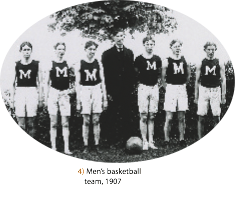
The earliest men’s basketball teams wore shorts longer than would be seen until the 1990s. (4) Photos show that early players’ jerseys, often made of wool, were handed down to become the track team’s uniforms.
Shiny short shorts and variations of the tank top dominated basketball courts for decades until street fashion invaded the gym. (5) The rise of rap and hip hop brought the comfort and cover-up players were ready for. Today’s basketball bottoms have traveled to below the knees. Uniform catalogues, in fact, now offer plus two-inch and plus four-inch additional lengths for the shorts … just in case.


Artifacts - WEB EXCLUSIVE
By Betsy HolmquistSteve Hackney
 "You can take 'toss' right out of your vocabulary," says Steve Hackney '72, head equipment manager for Intercollegiate Athletics (1). Hackney has kept a collection of Grizzly uniforms from his twenty-five-year tenure in the Hoyt Athletic Complex and takes his "no toss" theory even to the worn-out tube sock a player calls to his attention. "Turn it around," he'll advise. But true to his dedication to athletes, he then will make sure a new pair is provided. Hackney can talk injection-molded, polycarbonate, shimmer sheen overlay, or the intricacies of pre-wash, Fels Naptha, and extractor drying, because he's in charge of cleaning all uniforms and gear, as well as ordering and maintaining it. He sees future Griz football uniforms becoming even more sleek, tight, and resistant to grabbing by the opposing team. "It takes three players to get a jersey on some of these players," he says. "The jersey's what holds on the shoulder pads. They've gotta be tight. Even our biggest players wear only an XL. You don't see bellies anymore."
"You can take 'toss' right out of your vocabulary," says Steve Hackney '72, head equipment manager for Intercollegiate Athletics (1). Hackney has kept a collection of Grizzly uniforms from his twenty-five-year tenure in the Hoyt Athletic Complex and takes his "no toss" theory even to the worn-out tube sock a player calls to his attention. "Turn it around," he'll advise. But true to his dedication to athletes, he then will make sure a new pair is provided. Hackney can talk injection-molded, polycarbonate, shimmer sheen overlay, or the intricacies of pre-wash, Fels Naptha, and extractor drying, because he's in charge of cleaning all uniforms and gear, as well as ordering and maintaining it. He sees future Griz football uniforms becoming even more sleek, tight, and resistant to grabbing by the opposing team. "It takes three players to get a jersey on some of these players," he says. "The jersey's what holds on the shoulder pads. They've gotta be tight. Even our biggest players wear only an XL. You don't see bellies anymore."
Letter Sweaters and Jackets
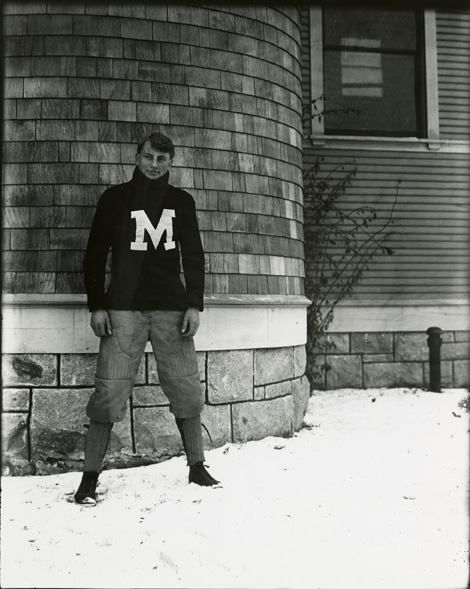
UM's first lettermen, members of the 1897 varsity team, wore V-neck cardigans with full block M letters. Lettermen next adopted bulky maroon turtlenecks with almost chest-covering Ms. (2) By the mid-1920s men's letter sweaters were again maroon cardigans with a gray M. Stripes knitted into the upper left sleeve designated the number of times each man had lettered.
The first women's letter sweaters were white, shawl-collared cardigans, with an Old English M. By the mid-1930s women letter winners were wearing maroon cardigans with the stylized English M. Maroon cardigan letter sweaters dominated until the late 1950s when lettermen jackets became the rage. Today's M jackets are long and box cut, in contrast to the earlier waist-length jackets. (3)
Olympia Knitting Mills, Inc. in Olympia, Washington, advertised its "Wil Wite" Award Letter Sweaters for years in the Sentinel–the brand Grizzly athletes wore for decades. (The 1938 Sentinel specifies a $4 fee that women athletes had to pay for their sweaters) Visit the Hall of Champions in the Adams Center to view letter sweaters, jackets, uniforms, shoes, helmets, and other equipment that tell the story of Intercollegiate Athletics.
COLORS
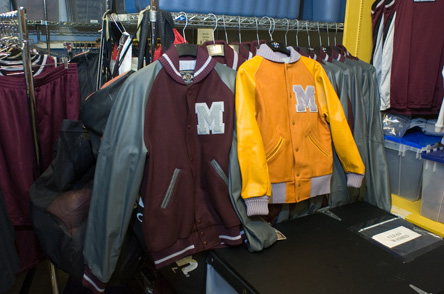
Maroon was substituted for copper in UM's official copper-silver-gold color scheme in letter sweaters and uniforms until 1967 when Coach Jack Swarthout replaced it with Texas orange, a color change that lasted until the end of the 1995 season. Today maroon and silver are the official colors of UM’s branded line of clothing.